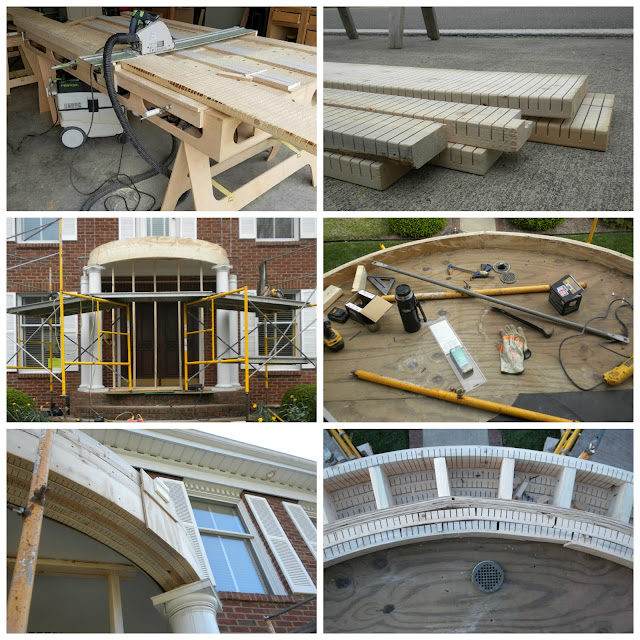Back in 2004, we renovated our property to incorporate our side lot as a brick-fenced, landscape garden, and added more character to the front house entry in the form of a balcony. When I say 'we', I mean we hired an architect and general contractor to carry out our design ideas. Twelve years later, the balcony is getting a major facelift.
We had a balcony designed in an arc shape over the front doorway, to soften the otherwise boxed appearance of the house's original construction. We removed the central window from the upper level, and replaced it with a door to access the small balcony from inside to out.The issues with the balcony were immediate. Water seeped into the structure from just outside the balcony railings, and managed to wreak havoc from the inside out. The original contractors came back within two months with a temporary solution, but the problem persisted. Two years later (2006), the original contractors dismantled the balcony and applied what they thought would be a permanent solution. The rebuild proved to be worse than ever, not only compromising the balcony appearance, but also exacerbating the water issue in years to come. And, believe it or not, two balustrades had been re-installed upside down, only to be discovered afterward (2007).
Through the years, caulking just outside the balcony railing was the ongoing bandaid solution. While the balcony's outside appearance worsened, attempts to engage contractors failed in the following years for these reasons: 1) no callbacks, 2) contractors showed with estimates but were no shows afterwards, even with followup calls, 3) contractors showed with estimates but put us in queue lines which never materialized after waiting a full year (another version of no show).
Fast forward, 2016: the work began March 28th. Before my tree guys finished their job in early March, I asked them if they knew of any good contractors. Score! Turns out, the contractor is one of the ones I had called four years prior, but this time he came - that same day the tree was cut down!
Demo day is always the quickest of all the work, it seems. The railings (a low-maintenance alternative to wood) were removed and are expected to be used again. It didn't take long to see that the damage was much more extensive than originally anticipated (by the contractor). You can see from the photo collage above the confirmed fear that the balcony was basically rotted from the inside out, almost entirely. The contractor ended up demolishing all the way back to the inner porch (where noted in green in the labeled photo earlier).
The collage below shows the extent of the demo process, each step peeling back more and more. We were dealing with the crazy March weather of extreme cold and wind, too, so the exposed balcony had to be covered with tarp more than once to save that center section which was still dry (there's a drain pipe built into that part for water runoff).
Even with inclement weather, though, this contractor worked in his workshop at home, preparing the rebuild materials, and texting me photos with progress reports on those days. He mentioned in one conversation how he understood why other contractors did not want to do this job: it is considered relatively small (yet it turned out big), AND the arc shape of the balcony presented real challenges.
You can see from the collage above, the wood had to be bent into the semi-circular shape of the arc. This was accomplished by the notch cuts in the boards (much like sewing cloth at necklines, armpits, waistbands, etc.). The thinner boards on the inner/outer layers were actually soaked (he went to the river!) to mold into shape.
After the outer frame was rebuilt, the next step was bringing in the subcontracted roofer, who then "dried in" the balcony top with a rubber roofing. You can see from the top right photo in the collage below that there is a drain on this roof, which is pitched, and a drainpipe is built in to take water away. It is from outside that ledge where the root problem occurred previously. Steps are being taken to not make the same mistake twice in the redesign and reconstruction.
As a sidetrack, when the roofers came, I was put to task in cleaning the roof pads, which lie on top of the rubberized seal. The photo below shows how those pads looked while in place. They became mildewy and nasty over time, as the front of the house faces north.
At some point in the past year or so, I had removed the pads (Mr. P theorized the water leak was somehow related, but it wasn't). The pads were stacked on the utility lane on the east side of our home, out of sight. The day the roofers came back, I spent two hours cleaning out muck and mulch that had accumulated in the grooves of the roof pads lying on the ground. After powerwashing both sides and laying the pads out in the courtyard to dry, my OCD kicked in for cleaning up random leaves, weeds. Another couple hours later, I had the utility lane area cleaned up, made a trip to the local Feed & Seed store for mulch, and finished the job. Turns out, the roof pads won't go back until further in the process. :/

The next step of the rebuild was actually more demolition. The columns (same, low-maintenance PVC product as the railings) had to come down so accurate measurements could be made of the arc radius for replacement. It was decided that the replacement materials covering the wood frame would be the same type of alternative millwork this time, not wood as before. All of this will be sealed properly this time, correcting the root cause of the damage from the get-go. The new material would ensure no rotting, even if residual water ran over the sealed edges of the balcony.
There was just one huge challenge in this solution: the PVC material is manufactured in flat sheets, and only bends with high heat (somewhere near 300°). Even with a successful bend, it molds within minutes, so the application must be quick. Breakage was a real concern. My contractor came up with a genius solution, MacGyver style!
After the radius measurements of that last step of demolition had been taken, my contractor went back to his workshop and constructed a model frame of the arc. He then devised a heating unit for the PVC material. Once heated sufficiently, his team molded the material onto the frame, and were able to clamp it into place, in order for it to set up.
The balcony is built in multi-dimensional layers for an aesthetically-pleasing appearance, so the contractor's team proceeded with the additional steps of heating the PVC material, bending it and layering it onto the prior layers. A crown molding finishes off the balcony frame. This part of the process took two days, while the outside temperatures remained in the low 40s at night, and still mild at 70° in the daytime.
I cannot begin to express my total joy and the great expectations I have with this balcony reconstruction. I was once told by a friend there are three things that can ruin a house - water, water, and water. If any of you have ever had water issues of any kind (and I've had more than my share with past homes), then you understand when I say it is my arch nemesis in home ownership.
The best facelifts are those which cannot be determined upon casual glance. If we are fortunate, such will be the case in this finished reconstruction of our balcony. Stay tuned for the reveal!
NOTE: For the balcony reveal, please visit this post: The Balcony is Complete!
Rita C. at Panoply
Sharing: BNOTP, Amaze Me, The Scoop, Inspire Me, WOW














No comments:
Post a Comment